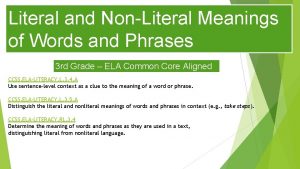Year 7 Poetry Metaphor Literal language if something

- Slides: 1

Year 7 Poetry Metaphor Literal language: if something is literal it is accurate or precise. • A literal description tells what actually happens. • Something that is literal reports on events. • An example would be ‘he is lazy’ Tenor, vehicle, ground A metaphor has three parts: The tenor: the thing you want to try and describe to your audience. The vehicle: The imaginative idea you compare it with to help your audience understand it. This is the ‘made up’ bit. The ground: the thing the tenor and the vehicle have in common. Here is an example: Metaphor: if something is a metaphor it is not literal. ‘Achilles fought like a lion’ (both Achilles and the lion are strong) • A metaphor does not report on what actually happens. Achilles is the tenor because he is the thing being described. The lion is the • A metaphor tells us more about something by bringing vehicle because it is the imaginative idea Achilles is compared to. The ground ideas together. is that they are both strong because this is what they have in common. • An example. The would be ‘he a couch poems andistheir key potato’ metaphors Both ‘the fog’ and the ‘little cat feet’ are grey, delicate ‘Fog’ – Carl Sandburg, 1878 – 1967 and move gently. 'The fog comes on little cat feet’ ‘November Night’ – Adelaide Crapsey, 1878 – 1914 Both ‘the leaves’ and ‘the steps of passing ghosts’ ‘like steps of passing ghosts, / The leaves, frost –crisp’d, rustle softly. break from the trees and fall’ ‘Dreams’ – Langston Hughes, 1902 – 1967 Both a life without dreams and ‘a broken-winged bird/ ‘… if dreams die/ Life is a broken-winged bird/ That cannot fly’ are sad and wasteful. ‘Sally’ – Phoebe Hesketh, 1909 – 2005 Both Sally and ‘a dog-rose’ are wild and not traditionally ‘She was a dog-rose kind of girl: / Elusive, scattery as petals’ beautiful. ‘Frogs’ – Norman Mac. Caig, 1910 – 1996 Both frogs and ‘parachutists’ leap into the air and spread ’In mid-leap they are/ parachutists falling/ in a free fall’ out when they fall. Both frogs and ballet dancers have ‘… their ballet dancer’s/ legs’ powerful and elegant legs. Both pigeons and ‘busybodies’ walk around looking like ‘Pigeons’ – Richard Kell, 1927 – ‘small blue busybodies/ Strutting like fat gentlemen’ they think they’re important. Both pigeons and fat ‘their heads like tiny hammers’ gentlemen have big bellies but look quite dignified. ‘The Eagle’ – Alfred, Lord Tennyson, 1809 – 1892 ‘And like a thunderbolt he falls’ ‘The Tyger’ – William Blake, 1757 – 1827 ‘Tyger, tyger burning bright’ ‘A Case of Murder’ – Vernon Scannell, 1922 – 2007 ‘The cat, half-through, was cracked like a nut’ ‘… the wound of fear gaped wide and raw’ ‘… the huge black cat pads out’ (the cat turns from tenor into vehicle for the boy’s fear) Both the eagle falling and ‘a thunderbolt’ are fast and dangerous. Both the tiger and fire are beautiful and powerful, but also difficult to control. Both the cat being slammed in a door frame and a nut being broken make a cracking sound. Both ‘fear’ and a ‘wound’ can be painful and can get worse. Both fear and a ‘huge black cat’ are haunting and can sneak up on you.

